 Digital
model accuracy
Digital
model accuracy Digital
model accuracy
Digital
model accuracyThe 800,000 polygon digital model scanned at 100
Ám was compared to the physical specimen by scaling on the computer screen and
by using microscopic techniques respectively.  The
dimensions, geometry, and color were identical on the digital model to that of
the specimen. Figure 6 is a composite
image comparing the digital model with a photograph of the physical
specimen. To the eye, even at increased magnification, it was not
possible to differentiate the specimen and the digital copy.
The
dimensions, geometry, and color were identical on the digital model to that of
the specimen. Figure 6 is a composite
image comparing the digital model with a photograph of the physical
specimen. To the eye, even at increased magnification, it was not
possible to differentiate the specimen and the digital copy. 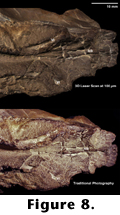 As
accuracy of the methodology has been previously rigorously tested under
demanding industrial conditions it was not deemed necessary to quantify the
verification process. However, visual examination of two regions
highlights examples of the accuracy of the digital model. Figure
7 illustrates the vidian canal; its structure can be seen easily in both the
model and the image of the physical specimen.
As
accuracy of the methodology has been previously rigorously tested under
demanding industrial conditions it was not deemed necessary to quantify the
verification process. However, visual examination of two regions
highlights examples of the accuracy of the digital model. Figure
7 illustrates the vidian canal; its structure can be seen easily in both the
model and the image of the physical specimen.  Figure
8 shows details of the abducens cranial nerve (VI) and the branch of the
internal carotid artery (ICB). The only limitation of digital models such as
shown is that they can only support a limiting amount of scaling (Fig.
9). The limitation of this scaling is related to two variables; the scanning
resolution and polygon reduction (Beraldin
et al. 1997).
Figure
8 shows details of the abducens cranial nerve (VI) and the branch of the
internal carotid artery (ICB). The only limitation of digital models such as
shown is that they can only support a limiting amount of scaling (Fig.
9). The limitation of this scaling is related to two variables; the scanning
resolution and polygon reduction (Beraldin
et al. 1997).
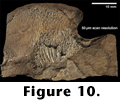 Figure
10 was scanned at 50 Ám resolution, and Figure
11 was scanned at 100 Ám resolution. Both models support substantial scaling
without facets appearing in the digital model.
Figure
10 was scanned at 50 Ám resolution, and Figure
11 was scanned at 100 Ám resolution. Both models support substantial scaling
without facets appearing in the digital model. 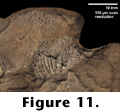 However,
when the 100 Ám digital model is scaled to more than 5x, facets become visible
on high angle surfaces (Fig. 12). In
contrast, the model scanned at a 50 Ám resolution supports much greater scaling,
to the point of exceeding the resolution of the texture map (Fig.
13).
However,
when the 100 Ám digital model is scaled to more than 5x, facets become visible
on high angle surfaces (Fig. 12). In
contrast, the model scanned at a 50 Ám resolution supports much greater scaling,
to the point of exceeding the resolution of the texture map (Fig.
13).
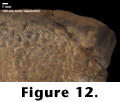 As
discussed earlier, to permit most researchers access to a version of this
complex digital model that can be manipulated, it was necessary to reduce the
number of polygons. Figure 3 is a
digital model comprised of 50,000 polygons scanned at a 100 Ám resolution. This
represents a 98% reduction in the number of polygons from the initial 3 million
polygon model and can only support a limited amount of scaling (1.5x) before
details apparent in the physical specimen are either obscured or absent (Fig.
14).
As
discussed earlier, to permit most researchers access to a version of this
complex digital model that can be manipulated, it was necessary to reduce the
number of polygons. Figure 3 is a
digital model comprised of 50,000 polygons scanned at a 100 Ám resolution. This
represents a 98% reduction in the number of polygons from the initial 3 million
polygon model and can only support a limited amount of scaling (1.5x) before
details apparent in the physical specimen are either obscured or absent (Fig.
14).
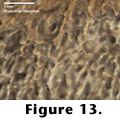 |
 |